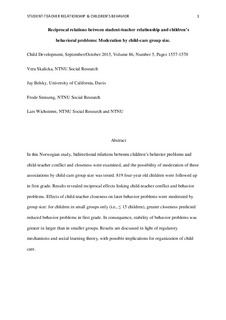| dc.contributor.author | Skalicka, Vera | |
| dc.contributor.author | Belsky, Jay | |
| dc.contributor.author | Stenseng, Frode | |
| dc.contributor.author | Wichstrøm, Lars | |
| dc.date.accessioned | 2017-12-22T14:07:44Z | |
| dc.date.available | 2017-12-22T14:07:44Z | |
| dc.date.created | 2016-01-04T11:56:30Z | |
| dc.date.issued | 2015 | |
| dc.identifier.citation | Child Development. 2015, 86 (5), 1557-1570. | nb_NO |
| dc.identifier.issn | 0009-3920 | |
| dc.identifier.uri | http://hdl.handle.net/11250/2473723 | |
| dc.description.abstract | In this Norwegian study, bidirectional relations between children's behavior problems and child–teacher conflict and closeness were examined, and the possibility of moderation of these associations by child-care group size was tested. Eight hundred and nineteen 4-year-old children were followed up in first grade. Results revealed reciprocal effects linking child–teacher conflict and behavior problems. Effects of child–teacher closeness on later behavior problems were moderated by group size: For children in small groups only (i.e., ≤ 15 children), greater closeness predicted reduced behavior problems in first grade. In consequence, stability of behavior problems was greater in larger than in smaller groups. Results are discussed in light of regulatory mechanisms and social learning theory, with possible implications for organization of child care. | nb_NO |
| dc.language.iso | eng | nb_NO |
| dc.publisher | Wiley | nb_NO |
| dc.title | Reciprocal Relations Between Student-Teacher Relationship and Children's Behavioral Problems: Moderation by Child-Care Group Size | nb_NO |
| dc.type | Journal article | nb_NO |
| dc.type | Peer reviewed | nb_NO |
| dc.description.version | acceptedVersion | nb_NO |
| dc.source.pagenumber | 1557-1570 | nb_NO |
| dc.source.volume | 86 | nb_NO |
| dc.source.journal | Child Development | nb_NO |
| dc.source.issue | 5 | nb_NO |
| dc.identifier.doi | 10.1111/cdev.12400 | |
| dc.identifier.cristin | 1305472 | |
| dc.relation.project | Norges forskningsråd: 203249 | nb_NO |
| dc.description.localcode | © 2015 The Authors. Child Development © 2015 Society for Research in Child Development, Inc. This is the peer reviewed version of the article, which has been published in final form at http://dx.doi.org/10.1111/cdev.12400. This article may be used for non-commercial purposes in accordance with Wiley Terms and Conditions for Self-Archiving. | nb_NO |
| cristin.unitcode | 194,67,40,0 | |
| cristin.unitname | Institutt for psykologi | |
| cristin.ispublished | true | |
| cristin.fulltext | postprint | |
| cristin.qualitycode | 2 | |
